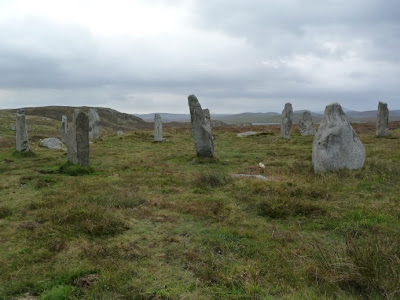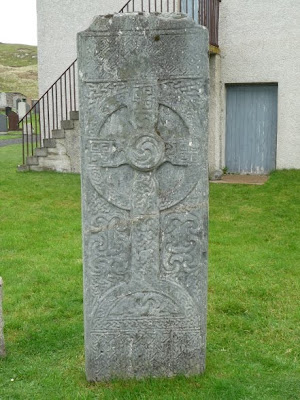From our perch above Loch Carron we drove on to Lochalsh and then, after a serious blackberry-picking bout (with the usual disdainful response from the locals), we drove across the Skye Bridge to the fabled Isle of Skye, the first of the inner Hebrides off Scotland's west coast. (The Sky Bridge south of St. Petersburg, FL, USA, is more impressive, as a bridge, but it does not have the scenery one finds here (although the Gulf sunsets in FL are pretty unbeatable)). We stopped for fueling and information in Broadford. Here, Vicki ascertained that the only Drambuie site on the island was at the Broadford Hotel, where the Bonnie Prince gave the secret recipe to the Mackinnons. Drambuie, so she was told, is manufactured and bottled in Edinburgh. Secretly, I add. Too bad. They should have a distillery tour, even if they are not distilling anything. I would have gone.
She also found the costs and timetables for the ferry from Uig, the northern port of Skye, to Tarbert, the southern port on the Harris/Lewis Islands. Harris/Lewis is an interesting phenomenon. They are one island, but go, regionally, by different names. Harris has the tweed, Lewis has the chess set and the stones.
I had pretty much written off the Stones of Callanish as a destination too far and too costly. The Outer Hebrides? Maybe in another life. But, suddenly, they were within reach, just a two hour ferry ride away. We did all the calculations and determined to ferry the Grey Wanderer over, so we'd have a place to sleep, eat and means of travel, thus saving all those costs. (We should have done the same for the Orkneys). So we headed north, toward Uig, enjoying the Skye highland and costal scenery, with a detour, midway up the island, to the Talisker distillery.
We proceeded on to Uig and the ferry, a big ferry, the MV Hebrides, 5,000 tons. Scottish ferries are far more formal than Norwegian ones. In Norway, you just queue up and drive on, buying a ticket from the guy/gal with the ticket-machine slung from his/her shoulder. No big thing. In Scotland, at least here, you go into an office, converse with someone at a counter (a very nice and informative person, in our case), who confers with a computer, buy your ticket, and receive a folder of documents. Then, as in Norway, you queue. From the staff there we learned the interesting story of the merchant vessel
Politician, which ran aground off the Isle of Eriskay during WWII with a cargo of some 250,000 bottles of Scotch bound for the US. The efforts of the thirsty locals versus the customs and excisemen to retrieve the cargo is the background of Compton MacKenzie's comedy novel
Whiskey Galore, later a feature movie. Must check it out.
The voyage aboard the MV Hebrides was fine, scenic among the various Hebridean islands and skerries. We landed and drove off the ferry in Tarbert, South Harris Island, as the sun was setting. Forty miles up the dark road, half-way across the island, we found a suitable lay-by on a secondary (tertiary? quarternary?) road, by the finger of a loch, and spent the night, already feeling quite far out on an islandic limb. Lewis/Harris/whatever is really out there. The moon is very, very low at this latitude, and it was very, very dark. I longed for a bottle of Dark Island, but had to settle for Drambuie.
 |
On the west of Skye, the Talisker Distillery, one of the great ones |
 |
Our ferry, the MV Hebrides |
 |
Isles and skerries in the Little Minch, which separates Skye and the outer islands |
 |
Cleared for landing, final approach to Tarbert... |



















































